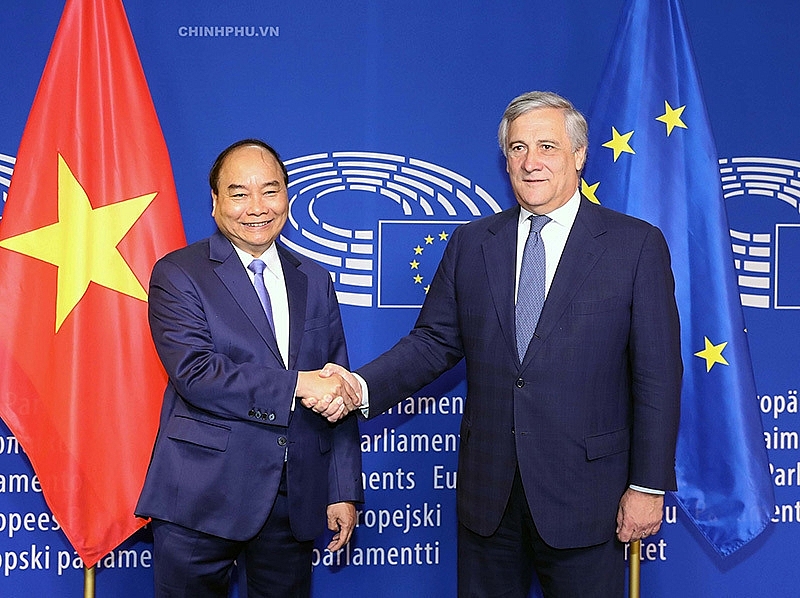EVFTA and EVIPA to be signed tomorrow
 |
| Prime Minister Nguyen Xuan Phuc and European Parliament President Antonio Tajani |
Tomorrow afternoon (June 30, 2019) in Hanoi, the EVFTA will be signed by Minister of Industry and Trade Tran Tuan Anh and the EVIPA will be inked by Minister of Planning and Investment Nguyen Chi Dung, marking the end of nine years of negotiations.
The EVFTA and the EVIPA are ambitious trade deals between the EU and a developing nation based on regulations. Under the EVFTA, 99 per cent of tariff lines will be removed, and many other non-tariff barriers will be reduced for both sides, while the EVIPA helps protect and enhance EU investments in Vietnam, making the Southeast Asian country a proactive trade and investment hub of EU firms in the region.
The EVFTA and EVIPA will help EU enterprises to access the public procurement and service markets in Vietnam while strengthening the protection of EU investments in the country. As a new-generation FTA, the EVFTA also includes important provisions on intellectual property protection, investment liberalisation, and sustainable development. On the latter, the FTA includes commitments to implement International Labour Organisation core standards and UN Conventions on climate change and biodiversity.
A few days ago, the Vietnamese Ministry of Industry and Trade said that the EVFTA and EVIPA were started and concluded in the context that bilateral relations between Vietnam and the EU have been developing well, especially in the fields of economy, trade, and investment. When implemented, the EVFTA will be a great boost to Vietnam's exports, helping to diversify its export markets and products, especially agricultural and aquatic products, as well as other Vietnamese products with competitive advantages.
Commitments to equal treatment and safe and adequate protection for each other's investments and investors in the EVIPA will also contribute positively to the construction of a transparent legal and investment environment, which will help Vietnam attract more investors from the EU and other countries.
According to the Ministry of Planning and Investment, the EVFTA will increase Vietnam’s export turnover to the EU by 20 per cent by 2020, 42.7 per cent by 2025, and 44.37 per cent by 2030, while import turnover from the EU will also raise at a lower rate than export, specifically 15.28 per cent by 2020, 33.06 per cent by 2025, and 36.7 per cent by 2030.
Regarding the macroeconomy, the EVFTA will contribute to the increase of Vietnam’s GDP by around 2.18-3.25 per cent (2019-2023), 4.57-5.3 per cent (2024-2028), and 7.07-7.72 per cent (2029-2033).
As one of the fastest-growing economies in Southeast Asia, Vietnam has become a promising destination for European businesses. Both Vietnam and the EU have seen huge potential in trade exchange across the field of automobile, industrial machine, sewage treatment, food and beverage, pharmaceuticals, and garment and textiles, among others.
Earlier, on September 2017, the EU proposed to separate the content regarding investment protection and investor-state dispute settlement (ISDS) from the EVFTA into another agreement. Thereby, the original EVFTA has become two agreements.
The EVFTA is the current agreement addressing foreign direct investment liberalisation only. The EU could approve the agreement and put it into temporary execution. Meanwhile, the EVIPA covers investment protection and ISDS, and needs the approval of both the European Parliament and country members’ parliaments before getting into execution.
On June 25, 2019, the European Council announced approving the EVFTA and EVIPA.
What the stars mean:
★ Poor ★ ★ Promising ★★★ Good ★★★★ Very good ★★★★★ Exceptional
Themes: EVFTA & EVIPA
Related Contents
Latest News
More News
- First members of Danang International Finance Centre revealed (December 22, 2025 | 17:39)
- Securing capital and efficiency for Vietnam’s 2026-2030 growth ambitions (December 17, 2025 | 10:00)
- Driving double-digit growth through green and circular transformation in Vietnam (December 17, 2025 | 09:00)
- Vietnam bucking trend in the global M&A landscape (December 16, 2025 | 14:20)
- Vietnam’s green transition demands collective financial action (December 15, 2025 | 12:00)
- VIR workshop highlights capital and policy for sustainable development (December 15, 2025 | 11:00)
- National Assembly approves pilot mechanisms to accelerate major projects in Hanoi (December 12, 2025 | 11:29)
- Vietnam eases policy approval requirements, simplifies foreign and outbound investments (December 11, 2025 | 17:53)
- Unpacking new momentum in Vietnam’s M&A market (December 10, 2025 | 09:59)
- Forum honours outstanding M&A deals, strategies, and advisory firms (December 09, 2025 | 18:22)

 Tag:
Tag:



























 Mobile Version
Mobile Version